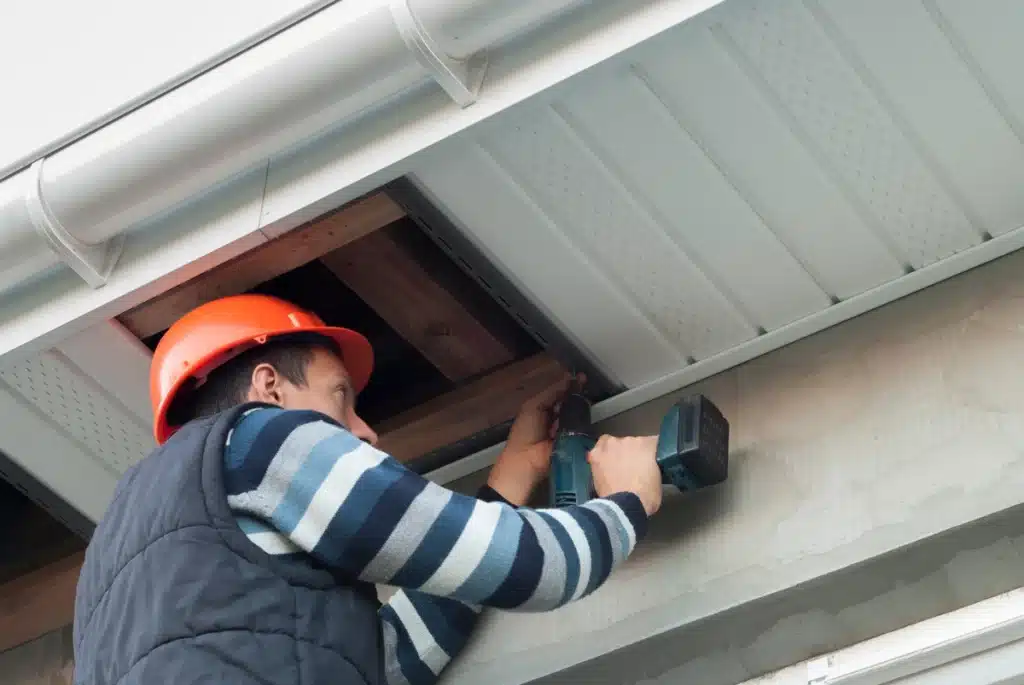Soffit Repair
Table of Contents
Your home’s roof plays a crucial role in protecting you and your family from the elements, but it’s the often overlooked components like soffits that contribute to its overall functionality. Soffit repair ensures these vital components continue to protect and enhance your home. Soffits, located under the eaves of your roof, not only provide a finished look to your home’s exterior but also serve important functional purposes.

However, like any other part of your home, soffits can experience wear and tear over time, requiring soffit repair and maintenance to ensure their longevity and effectiveness. In this blog, we’ll take a deep dive into everything you need to know about soffit repair, from:
- Understanding what soffits are
- Recognizing signs of damage
- Performing repairs
- Maintaining them for years to come
What is a Soffit?
Before we dive into the intricacies of soffit , let’s first understand what exactly a soffit is. The soffit is the exposed surface beneath the overhanging section of a roof eave. Its primary function is to provide ventilation to the attic space, allowing air to flow freely and preventing moisture buildup, which can lead to mold and rot. Additionally, soffits help to enhance the aesthetic appeal of your home’s exterior by providing a clean, finished look to the underside of the roof overhang.
Different Soffit Styles
Soffits come in various styles and materials, allowing homeowners to choose an option that complements their home’s architecture and personal preferences. Understanding the material can also aid in selecting the appropriate soffit method. Some common soffit styles include:
- Vinyl Soffits: Durable, low-maintenance, and affordable, making them a common choice for soffit repair.
- Aluminum Soffits: Lightweight, weather-resistant, and available in smooth or textured finishes.
- Wood Soffits: Classic and natural in appearance but require regular maintenance to prevent rot and insect damage.
- Fiber Cement Soffits: Durable, moisture-resistant, and fire-resistant, offering an excellent alternative for soffit repair projects.
Signs of Soffit Damage

Recognizing signs of soffit damage early is crucial to prevent further deterioration and costly soffit repair. Here are some common indicators that your soffits may need attention:
- Water Damage: Stains or discoloration on the soffit surface.
- Pest Infestation: Evidence such as chew marks, holes, or nests in the soffit material.
- Peeling or Cracked Paint: Exposing underlying material to moisture and decay.
- Sagging or Warping: Indicating structural issues or water damage that necessitate soffit repair.
How to Repair Your Soffit: 6 Steps
While some soffit repair tasks may require professional assistance, minor issues can often be addressed by homeowners with basic tools and materials. Here’s a step-by-step guide to performing soffit repair:
- Clean the Soffit: Begin by cleaning the soffit surface to remove dirt, debris, and loose material. A clean surface ensures effective soffit repair.
- Inspect for Damage: Check for signs of water stains, cracks, pest activity, or sagging. Identifying damage is the first step in planning your soffit repair.
- Repair Cracks and Holes: Use silicone caulk or sealant to fill small cracks or holes. This quick soffit repair solution prevents further deterioration.
- Replace Damaged Panels: For irreparable damage, replace affected panels with new ones of the same material and style.
- Secure Loose Panels: Reattach sagging or loose panels to the underlying structure using nails or screws for a secure soffit repair.
- Address Pest Infestation: Safely eradicate pests before completing your soffit repair to prevent recurring issues.
How to Maintain Your Soffits
Regular maintenance can prevent the need for frequent soffit repair. Follow these tips to keep your soffits in top condition:
- Clean Regularly: Remove dirt and mold buildup to extend the life of your soffits.
- Trim Overhanging Branches: Prevent branches from damaging the soffits during storms.
- Inspect for Damage: Regular checks help catch small issues before they require major soffit repair.
- Ensure Proper Ventilation: Keep attic vents clear to promote airflow and reduce moisture buildup.
- Repaint as Needed: Painted soffits should be monitored and repainted periodically to maintain their protective finish.
The Cost to Repair Soffit Systems
The cost of soffit repair varies based on damage extent, materials, and whether professional assistance is required. Minor repair tasks can often be done by homeowners at minimal cost. For extensive repairs or replacements, hiring a professional contractor may be necessary, with costs ranging from a few hundred to several thousand dollars.

Protect Your Roofing System With Tectum
Your home’s soffits play a vital role in maintaining its structural integrity and aesthetic appeal. By understanding what soffits are, recognizing signs of damage, performing necessary soffit repair, and implementing regular maintenance practices, you can ensure that your soffits remain in excellent condition for years to come.
Ready for a soffit repair or replacement? Contact Tectum Roofing for all your roof repair and replacement needs. We specialize in professional soffit services to keep your home protected and looking great.



